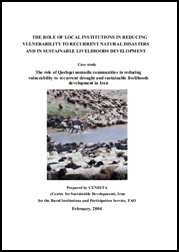
THE ROLE OF LOCAL INSTITUTIONS IN REDUCING VULNERABILITY TO RECURRENT NATURAL DISASTERS AND IN SUSTAINABLE LIVELIHOODS DEVELOPMENT
Case study
The role of Qashqai nomadic communities in
reducing vulnerability to recurrent drought and sustainable livelihoods
development in Iran
Prepared by CENESTA
(Centre for Sustainable Development), Iran
for the Rural Institutions and Participation Service, FAO
February, 2004